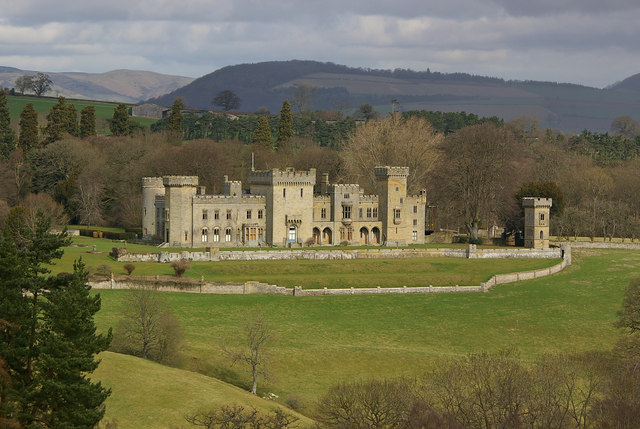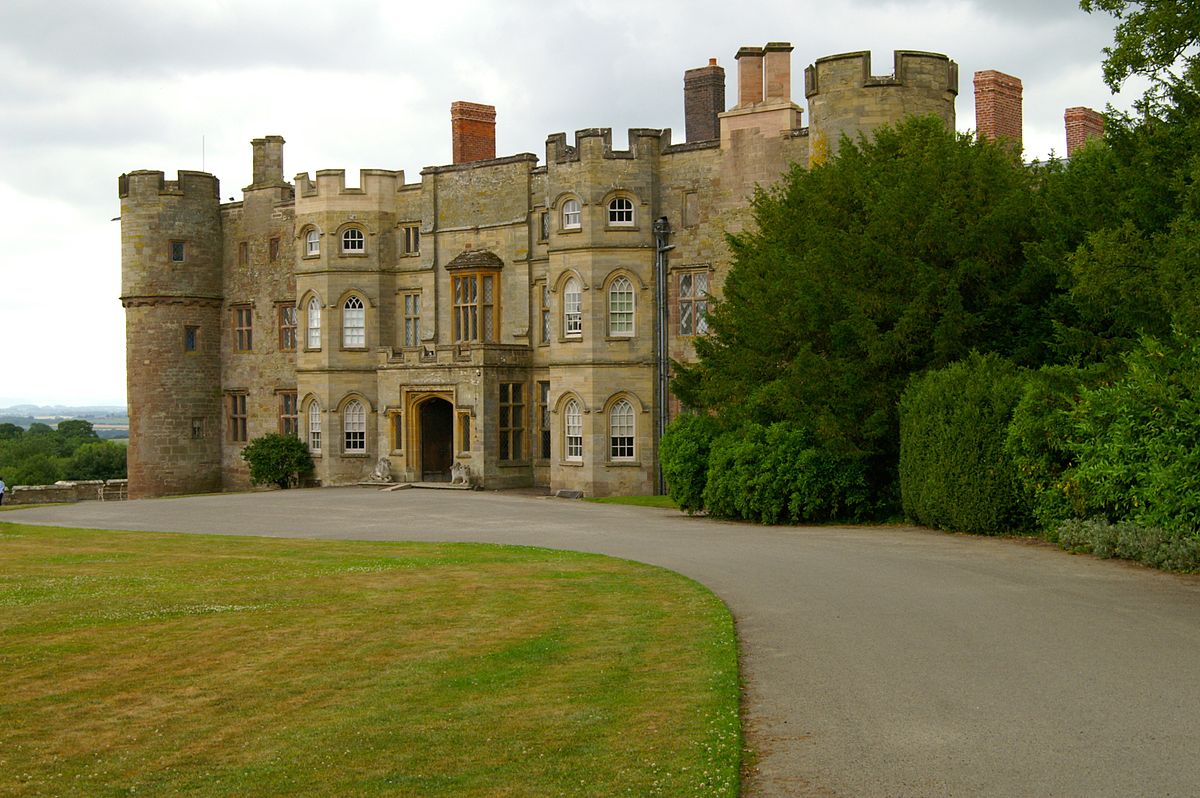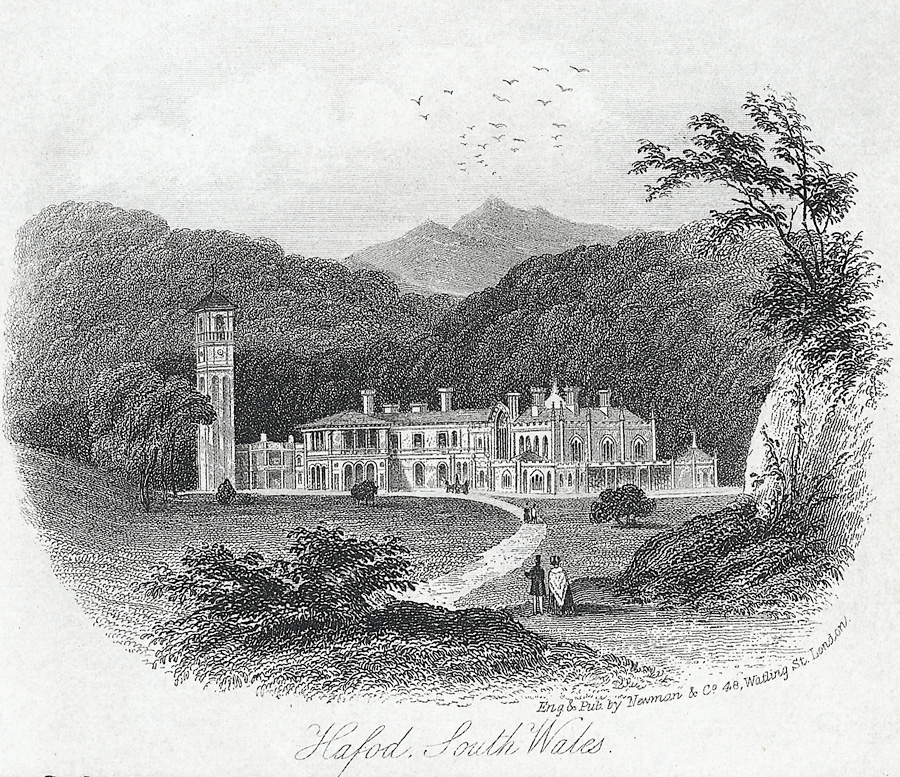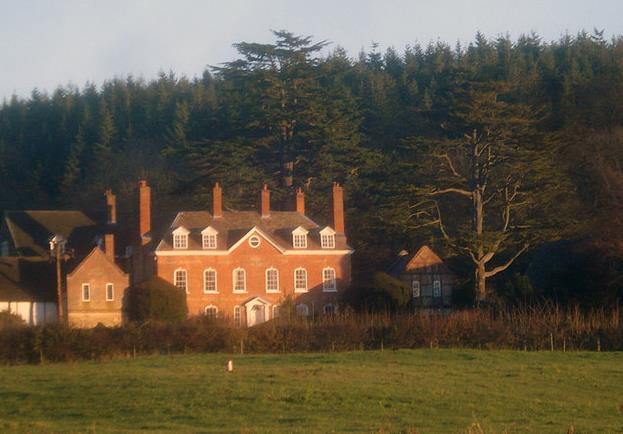Downton Castle |
Croft Castle |
 |
 |
Hafod Uchtryd |
Elton Hall |
 |
 |
by Laura Knight
Richard Knight (1659-1745),[3] of Downton Hall, in the parish of Downton on the Rock in Herefordshire, England (situated about 5 miles (8.0 km) west of Ludlow), was a wealthy ironmaster who operated the Bringewood Ironworks,[4][5] on the Downton estate, and founded a large fortune and family dynasty.
He was born in 1659, the son of Richard Knight of Madeley, Shropshire.
He was engaged in the iron trade at the time of the Commonwealth and acquired great wealth by the ironworks of Shropshire.
He married Elizabeth Payne (1671-1754), a daughter of Andrew Payne of Shawbury in Shropshire, by whom he had progeny 4 sons as follows:
I. Richard II Knight (1693-1765), eldest son, of Croft Castle (which he purchased from the Croft family in 1746, one year after his father's death) in the parish of Yarpole, Herefordshire, about 5 miles south of Downton, who married Elizabeth Powell, daughter of Samuel Powell of Stanedge, Radnorshire, by whom he had a sole daughter and heiress:
A. Elizabeth Knight, who married Thomas I Johnes (c.1721–1780) of Llanfair Clydogau, MP for Radnorshire (1777–80). In the 1760s he remodelled Croft Castle in the Rococo-Gothic style to the design of the architect Thomas Pritchard (d.1777). They had numerous progeny, including:
1. Thomas II Johnes (1748-1816) of Croft Castle, MP, who adopted the additional surname of Knight (according to the mural monument he erected 1813/16 to his ancestors in the chapel of Croft Castle), a pioneer in the field of agriculture. He purchased another estate at Hafod Uchtryd, Ceredigion, Wales, 65 miles away, the manor house of which he filled with valuable works of art. He planted 3 million trees on the Hafod estate and created a highly picturesque landscape painted in 1789 by J. M. W. Turner (1775-1851). He met with financial difficulties and sold Croft Castle in the 1780s to Somerset Davies[14] (c.1754-1817), MP for Ludlow in 1783. He continued to reside at Hafod, badly damaged by fire in 1807.
II. Rev. Thomas Knight (1697–1764), 2nd son, of Wormsley Grange, Rector of Bewdley, Worcestershire, who married Ursula Nash, a daughter of Frederick Nash of Dinham, Shropshire, by whom he had progeny:
A. (Richard) Payne Knight (1750-1824), eldest son, MP and a connoisseur of art, who rebuilt Downton in the Gothic revival style, as Downton Castle, surviving today. Died unmarried.
B. Thomas Andrew Knight (1859-1838), of Elton Hall in the parish of Elton in Herefordshire (3 miles south-east of Downton) and later of Downton Castle (which he inherited from his elder brother), a horticulturalist and botanist who served as the 2nd President of the Royal Horticultural Society (1811-1838). He married Frances Felton, a daughter of Humphry Felton of Woodhall in Shropshire, by whom he had surviving progeny 4 daughters, including:
1. Charlotte Knight (c.1801-14 May 1842), a notable horticulturalist, who in 1824 married Sir William Edward Rouse-Boughton, 2nd and 10th Baronet (1788-1856), a Member of Parliament for Evesham in Worcestershire. She was the heiress of her father's Downton Castle estate, although the inheritance was unsuccessfully contested by her senior male cousin (John II Knight (1765-1850),[19] of Wolverley, the pioneering developer of the Forest of Exmoor in Somerset) in the lengthy and famous lawsuit of Knight v Knight (1836–40).
III. Edward Knight (1699-1780), 3rd son, of Wolverley House, Wolverley in Worcestershire, who in 1726 married Elizabeth James, heiress of Olton End near Solihull, Warwickshire, by whom he had progeny:
A. Edward Knight (1734-1812), unmarried
B. James Knight (1735-1808) of Ludlow, died without issue.
C. John I Knight (1740-1795), 3rd son, of Lea Castle, Wolverley, and of Wolverley House, who married Henrietta Cunyngham, daughter of Daniel Cunyngham, by whom he had 2 sons:
1. John II Knight (1765-1850), eldest son, of Lea Castle (which he built circa 1809 and sold in 1818[22]), Wolverley, of 52 Portland Place in London, and of Simonsbath House, Exmoor, Somerset, an agricultural pioneer who commenced the reclamation of the barren moorland of the former royal forest of Exmoor in Devon and Somerset.
2. Thomas Knight (1775-1853) of The Mount, Papcastle, Cumbria, a noted mathematician.[23] His elder brother sued him in the celebrated 1840 lawsuit Knight v Knight, concerning the inheritance of their cousin Payne Knight (1750-1824), of Downton Castle. He married Isabella Walker, by whom he had 8 sons and 6 daughters.
IV. Ralph Knight (1703-1754), 4th son, of Bringwood, Herefordshire, who married Mary Duppa, daughter of Duppa Duppa of Longueville, Shropshire, by whom he had one son and 5 daughters including:
A. Thomas Knight (d.1803) of Henley Hall, died unmarried.
Here we take a look at the properties mentioned in the above sketch as they were to become the subject of a major lawsuit amongst the heirs:
Knight v Knight (1840) 49 ER 58 is an English trusts law case, embodying a simple statement of the "three certainties" principle. This has the effect of determining whether assets can be disposed of in wills, or whether the wording of the will is too vague to allow beneficiaries to collect what appears on the face of the will to be theirs. The case has been followed in most common law jurisdictions.
Richard I Knight (1659–1749) of Downton in the parish of Downton on the Rock in Herefordshire, a wealthy ironmaster from Madeley, Shropshire, proprietor of the Bringewood Ironworks, and founder of the family's fortune, made a settlement on 26 April 1729, which passed the manors of Leintwardine and Downton, Herefordshire, including Croft Castle down the family line. The first grandson (son of his second son Rev. Thomas Knight (1697–1764) of Wormsley Grange, Rector of Bewdley, Worcestershire) was (Richard) Payne Knight (1750-1824), MP, an art connoisseur (and specialist on phallic imagery), who re-built the old manor house at Downton in the Gothic revival style as Downton Castle. Payne Knight made his will on 3 June 1814, leaving the property to his brother, Thomas Andrew Knight (a horticulturalist), and in tail male to his male descendants. But if there were none, the property was to pass to the "next descendant in the direct male line of my late grandfather, Richard Knight of Downton". However, he also stated:
"I trust to the liberality of my successors to reward any others of my old servants and tenants according to their deserts, and to their justice in continuing the estates in the male succession, according to the will of the founder of the family, my above-named grandfather".
Thomas Knight died intestate, having been pre-deceased by his only son. His daughter, the horticulturalist Charlotte Knight (c.1801-1843), had married Sir William Edward Rouse-Boughton, 2nd and 10th Baronet (1788-1856), a Member of Parliament for Evesham. Payne's uncle, Edward Knight (1699-1780) (3rd son of the patriarch Richard I Knight), had a grandson John Knight (1765-1850), of Lea Castle, Wolverley, the pioneering developer of the Forest of Exmoor in Somerset, who brought a claim alleging that Thomas had been bound to make a strict settlement in favour of the male line, of which he was the senior representative. Sir William Rouse-Boughton argued that no such trust had been created and that the property had in fact gone to Thomas absolutely, and thus on to Charlotte and his family.
Lord Langdale MR held that the words of Payne's will were not sufficiently certain, which meant that there had been an absolute gift to Thomas, who had taken the property unfettered by any trust in favour of the male line. He formulated a legal test, now known as the "three certainties". This test specified that for a valid trust to be created, there must be three certainties:
(1) Certainty of intention: there must be intention to create a trust;
(2) Certainty of subject matter: the assets constituting the trust must be readily determinable;
(3) Certainty of objects: the people to whom the trustees are to owe a duty must be readily determinable.
His judgment was as follows. As a general rule, it has been laid down, that when property is given absolutely to any person, and the same person is, by the giver who has power to command, recommended, or entreated, or wished, to dispose of that property in favour of another, the recommendation, entreaty, or wish shall be held to create a trust.
First, if the words are so used, that upon the whole, they ought to be construed as imperative;
Secondly, if the subject of the recommendation or wish be certain; and,
Thirdly, if the objects or persons intended to have the benefit of the recommendation or wish be also certain.
In simple cases there is no difficulty in the application of the rule thus stated.
If a testator gives £1,000 to A. B., desiring, wishing, recommending, or hoping that A. B. will, at his death, give the same sum or any certain part of it to C. D., it is considered that C. D. is an object of the testator's bounty, and A. B. is a trustee for him. No question arises upon the intention of the testator, upon the sum or subject intended to be given, or upon the person or object of the wish.
So, if a testator gives the residue of his estate, after certain purposes are answered, to A. B., recommending A. B., after his death, to give it to his own relations, or such of his own relations as he shall think most deserving, or as he shall choose, it has been considered that the residue of the property, though a subject to be ascertained, and that the relations to be selected, though persons or objects to be ascertained, are nevertheless so clearly and certainly ascertainable—so capable of being made certain, that the rule is applicable to such cases.
On the other hand, if the giver accompanies his expression of wish, or request by other words, from which it is to be collected, that he did not intend the wish to be imperative: or if it appears from the context that the first taker was intended to have a discretionary power to withdraw any part of the subject from the object of the wish or request: or if the objects are not such as may be ascertained with sufficient certainty, it has been held that no trust is created. Thus the words “free and unfettered,” accompanying the strongest expression of request, were held to prevent the words of the request being imperative. Any words by which it. is expressed or from which it may be implied, that the first taker may apply any part of the subject to his own use, are held to prevent the subject of the gift from being considered certain; and a vague description of the object, that is, a description by which the giver neither clearly defines the object himself nor names a distinct class out of which the first taker is to select, or which leaves it doubtful what interest the object or class of objects is to take, will prevent the objects from being certain within the meaning of the rule; and in such cases we are told (2 Ves. jun. 632, 633) that the question “never turns upon the grammatical import of words—they may be imperative, but not necessarily so; the subject-matter, the situation of the parties, and the probable intent must be considered.” And (10 Ves. 536) “wherever the subject, to be administered as trust property, and the objects, for whose benefit it is to be administered, are to be found in a will, not expressly creating a trust, the indefinite nature and quantum of the subject, and the indefinite nature of the objects, are always used by the Court as evidence, that the mind of the testator was not to create a trust; and the difficulty, that would be imposed upon the Court to say what should be so applied, or to what objects, has been the foundation of the argument, that no trust was intended;” or, as Lord Eldon expresses it in another case (Turn. & Russ. 159), “Where a trust is to be raised characterised by certainty, the very difficulty of doing it is an argument which goes, to a certain extent, towards inducing the Court to say, it is not sufficiently clear what the testator intended.”
I must admit, that in the endeavour to apply these rules and principles to the present case, I have found very great difficulty; that in the repeated consideration which I have given to the subject, I have found myself, at different times, inclined to adopt different conclusions; and that the result to which I have finally arrived has been attended with much doubt and hesitation.
The testator, at the date of his will, was entitled in fee to a large real estate, and absolutely entitled to a very considerable personal estate. Of the largest part of the real estate he had been tenant in tail, under the dispositions made by his grandfather Richard Knight; he had suffered recoveries, whereby he became entitled to the same estate in fee; and the question is, whether by the will he meant to impose on his brother, Thomas Andrew Knight, the trust or duty of making such a settlement as is alleged by the Plaintiffs; or such a settlement upon some of the male descendants of the grandfather as would, under the will of Thomas Andrew Knight, give a right to the Defendant, Thomas Knight of Pap Castle; or did he mean that his brother was to have over the estate the same power which he himself had acquired and enjoyed; and which by his will he exercised for the purpose of transmitting the estate to the next male heir of his grandfather, and which he wished his successors to use in the same manner for the further transmission of the estates in the same line. And I am of opinion, though, I admit, after great doubt and hesitation, that the testator did not intend to impose an imperative trust on his successor, and that his will ought not to be construed to have that effect.
As he who had made himself absolute owner of the property had conceived himself bound in honour to transmit it to the male line of his grandfather, so he wished the same sentiment to govern his successors. He was pleased to speak of the honour and integrity of his family, and he expressed his trust or reliance on the justice of his successors; but it does not appear to me that he intended to subject them, as trustees, to the power of this Court, so that they were to be compelled to do the same thing which he states he trusted their own sense of justice would induce them to do.
It is a common observation in all such cases, that the testator might, if he had intended it, have created an express trust; but the authorities shew that if there be sufficient certainty, and nothing in the context of the will to oppose the conclusion, the trust may and must be implied; and the question is, whether there is a trust by implication.
He gave all his estates, real and personal (except as therein mentioned), to his brother, or to the next descendant in the direct male line of his grandfather, who should be living at the time of his death. The gift is in terms which make the devisee the absolute owner, and give him the power of disposing of the whole property (with such exceptions as are mentioned) as he pleases. The exceptions, deductions, or reservations consist of certain gifts for charitable and other purposes; and he constitutes his devisee sole executor and trustee to carry his will into execution, “confiding in the approved honour and integrity of his family to take no advantage of any technical inaccuracies;” and the context appears to me to shew, that these words relate to the reservations which he had made out of the general devise and bequest to his brother or the next descendant in the direct male line of his grandfather. The expressions used in his great bequest to the British Museum, afford additional evidence of his wish to maintain the distinction of his family in the same line; but I think that the question in the cause depends on the effect to be given to the last sentence in the will. Having given all his estates, real aud personal, to his successor, that is, the next male descendant, and having given a few legacies, he says, “I trust to the liberality of my successors to reward any others of my old servants and tenants according to their deserts, and to their justice in continuing the estates in the male succession, according to the will of the founder of the family, my above-named grandfather Richard Knight.”
In this passage there is no doubt of the wish, or of the line of succession, in which the testator desired the estates (whatever he meant by that term) to devolve or be transmitted.
Contemplating his successors, and, as it would seem, all his successors without limit in that line, he says, that he trusts to their liberality for one purpose, and to their justice for another. So far as he trusts to their liberality to reward any of his old servants or tenants, according to their deserts, he cannot be understood to have intended to create an imperative trust. Notwithstanding the use made of the word “trust,” an indefinite discretion was, in that respect, left with the successors; and it is difficult to suppose, that having in this sentence used the word “trust” in a sense consistent with an indefinite discretion in the person trusted, he should, in the same sentence, use the word “trust” in a sense wholly inconsistent with such discretion;—in a sense which imposed an absolute obligation to resort to the most refined subtleties of the law for the purpose of executing a trust in such a manner as to preserve, by compulsion, the succession to the estate in the same line for the longest time possible. Admitting the wishes of the testator, which seem to me sufficiently expressed, I have found an insuperable difficulty in coming to a satisfactory conclusion that he did not intend to rely on the honour, integrity, or justice of his family or successors for the performance of his wishes, but did intend to impose upon his successors an obligation to be enforced by legal sanction: and the impression arising from the last words in the will appears to me to be increased by a consideration of the preceding parts. He gave absolute estates; as to the gifts to other persons, he confides in the approved honour and integrity of his family that no advantage will be taken of technical inaccuracies to defeat them; and as to the succession of the estates intended to pass in the line he had chosen, he trusts to their justice. It seems to me, as if he had said, “you see my sense of what is due to the founder of the family; under his will, I have inherited the estates which his industry and abilities acquired, and of which he had, therefore, the best right to dispose. I have, by my own act, made myself absolute master of the estates, but I think it just to continue the succession in the same manner: this I do by my will, and I trust to your justice to do the like.” If this were his meaning, it is consistent with an intention that each successor should take from his immediate predecessor, by gift proceeding from a sense of justice, or by descent from the same motive, an absolute interest in the estates; and that the continuance in the line designated should be provided for in that way.
I think, therefore, that there is great reason to doubt the intention to create an imperative trust: and looking to the subject to which his wishes were directed—observing the absolute gift of all his estates, real and personal, with certain exceptions; and that, in the last clause, he has not used the words “my said estate,” or any words clearly and certainly indicating all that he had given to those whom he has called his successors, but had simply used the words, “the estates,” leaving it be matter of by no means easy construction, whether he intended under that expression to include the personal estate as well as the real; and it not being certain, having regard to the subsequent reference to the will of his grandfather, whether he meant to include more than the estates of his grandfather, to which he had himself succeeded; and observing that some part of the personal estate, at least, was subjected to the liberality of his successors, I think that there is reason to doubt whether the subject is sufficiently certain for a trust of this nature.
The objects do appear to me to be indicated with sufficient certainty, and it seems to me clear in what order he wished them to take. But, unless they were to take successively as absolute owners, I cannot discover what estates they were intended to take. I have not been able to persuade myself that the testator meant to tie down his successor to make such a settlement as is proposed by the Plaintiffs, and nothing less would give the Plaintiffs any right to ask for a decree of this Court in their favour; and if I might be permitted to adapt the words of Lord Rosslyn, in the case of Meggison and Moore (2 Yes. jun. 633), to the circumstances of this case, I should say, that “if I were imperatively to declare that the successors designated by the will should take only for life and their issue in strict settlement, I should do a thing most foreign to the testator's intention. His successor might have done what is suggested. The testator intimated a wish to him, and gave sufficient power; but I cannot say that he has left it to the Court of Chancery to accomplish his wishes.”
On the whole, I am under the necessity of saying, that for the creation of a trust, which ought to be characterised by certainty, there is not sufficient clearness to make it certain that the words of trust were intended to be imperative, or to make it certain what was precisely the subject intended to be affected, or to make it certain what were the interests to be enjoyed by the objects.
It appears to me, therefore, that the Plaintiffs have not made out any title, and that the bill ought to be dismissed.
Burke's Genealogical and Heraldic History of the Landed Gentry, 15th Edition, ed. Pirie-Gordon, H., London, 1937, p.1306, pedigree of Rouse-Boughton-Knight of Downton Castle
Victoria County History, Worcestershire, Vol.3, 1913, Parishes: Wolverley, pp.567-573
Burke's Genealogical and Heraldic History of the Landed Gentry, 15th Edition, ed. Pirie-Gordon, H., London, 1937, p.1305, pedigree of Knight of Wolverley (1840) 3 Beav 148, 173-180
Greene, Miranda, The Knight family and the British iron industry: the Bringewood Partnership, 2005, published on Herefordshire Through Time, Herefordshire Council website
Page, Robert, Richard and Edward Knight: Ironmasters of Bringewood and Wolverley, Transactions of Woolhope Nat. Field Club, Vol.43(1), 1979, pp.7–17.
Ince, L., The Knight Family and the British Iron Industry, 1991